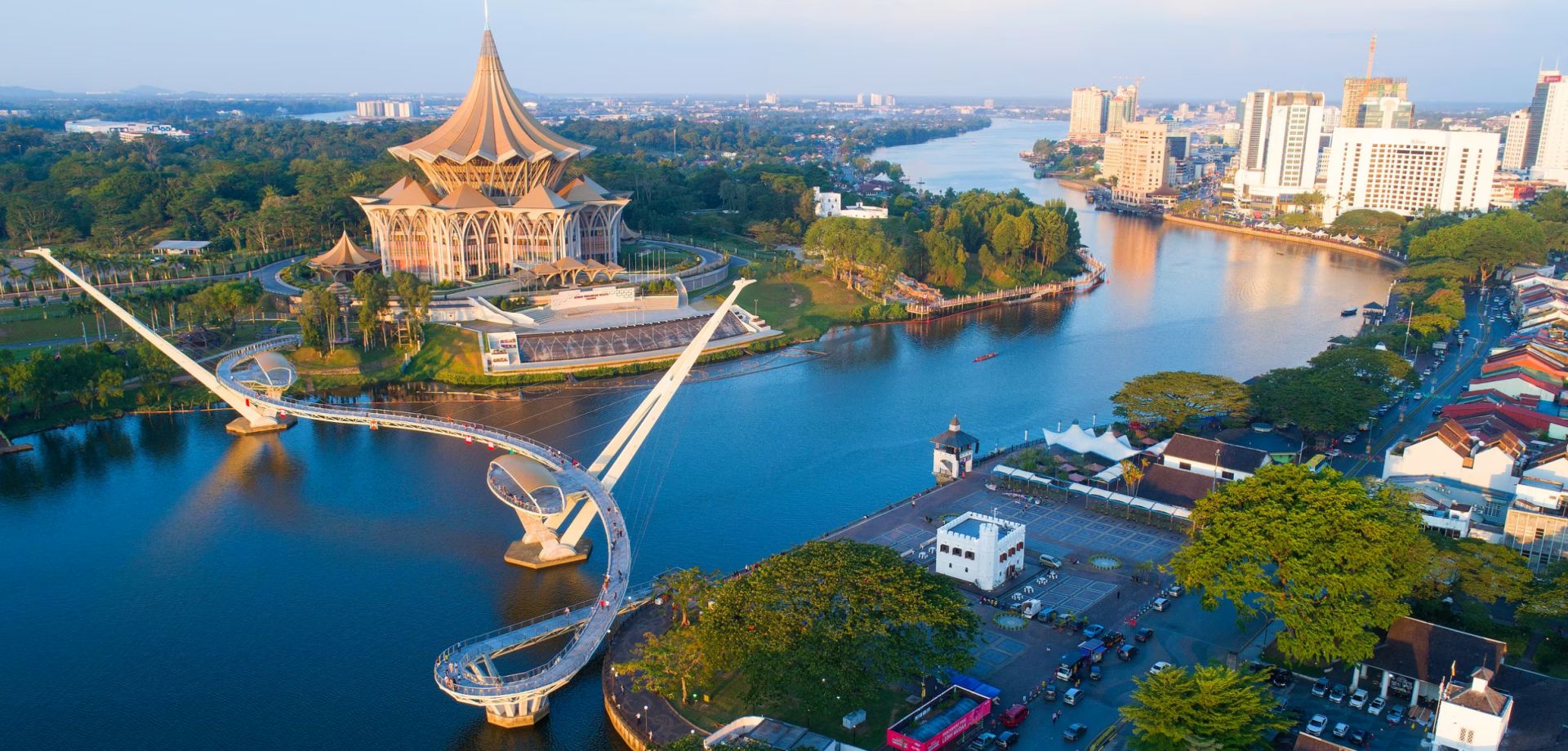The popular Sarawak capital city is a wealth of travel treasures just waiting to be discovered.
On the open road ahead of us, the mist-shrouded mountains loom, silent sentinels that bear testimony to the passing of the ages against the opal blue sky. Far from the drone of traffic and city smog, a single motorcycle cruises at its rider’s own pace, resistant to the fact that our car tails him close behind. To the left and right, patches of agriculture speckle the grass verge, corn, bananas, sugarcane, and other vegetables. We are meandering our way along the trail to the Annah Rais longhouse, located roughly sixty kilometres from Sarawak’s Kuching city, but seemingly worlds away. Leaving the main road, we take a sharp right turn and minutes later, spot the familiar bamboo entrance that up to now, has only been a photo in a travel article – the Bidayuh longhouse that housed generations of headhunters in an era long past.
Armed with hot, crisp pisang goreng purchased from a friendly elderly man speaking perfect English, we ascend the narrow stairs to the upper deck to seek out Annah Rais’ panggah, its intriguing house of skulls. Natives smile, plying jungle honey, bamboo shoots and tribal trinkets in front of their quarters, and we are waved across a creaking bamboo platform in the direction of this notorious trophy shed. It is small, but with a quickening heartbeat, I climb the steps, and once inside, contemplate in quiet reverence the greying skulls in their metal cage. Belonging to enemies from rival tribes and gathered over nearly two centuries, they remain a chilling reminder of a proud, yet bloody past. Now, though headhunting may be a distant memory in the peaceful foothills of the Borneo Highlands, over eighty families of Bidayuh ancestry live on at Annah Rais, paying tribute to their forebearers in this wooden hut, deep in the mountains.
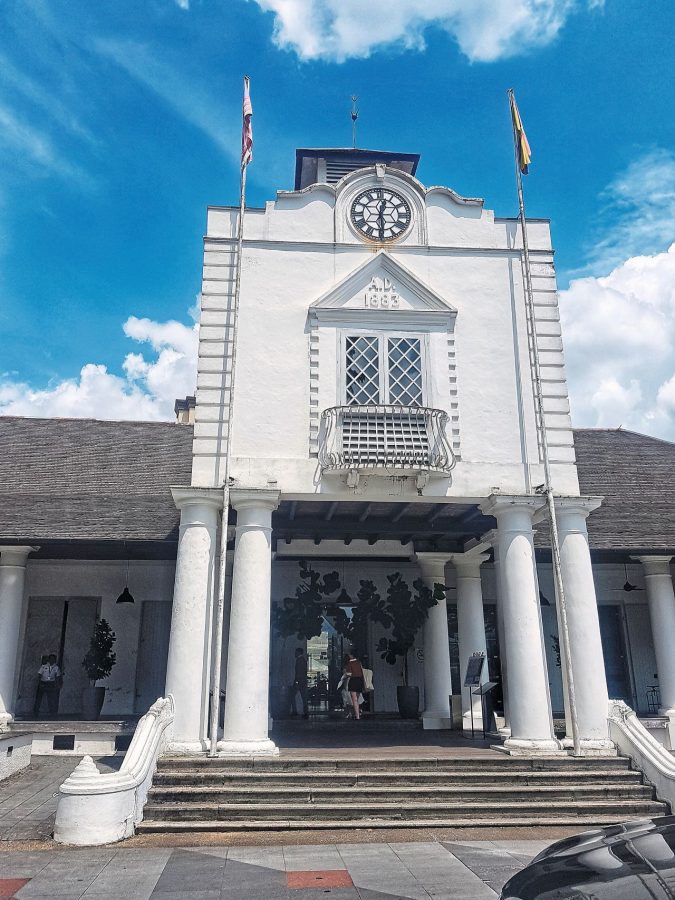
CATS IN CHINATOWN
With its beguiling tribal cultures and jungle highlands, Kuching merges its past and present in captivating ways. Just five days after the city’s famed Rainforest Festival in June, the party vibe still tinges the air and a cosmopolitan crowd stays on to enjoy Cat City’s food and culture. According to some stories, Kuching, meaning ‘cat,’ is a name that comes from the belief that the city was overrun by rats in the 1950s. To exterminate them, the British released nearly 14,000 cats which, generations after, remain a fuzzy, much-loved part of the local community. Most homes and businesses sport resident felines, much to the delight of cat-loving visitors. Another rationale for the city’s name involves the Chinese who migrated here in the last century. The word ku means ‘old,’ while ching means ‘well,’ a reference to an old waterhole that was once the main source of water in the area and remains today in the city’s Chinatown.
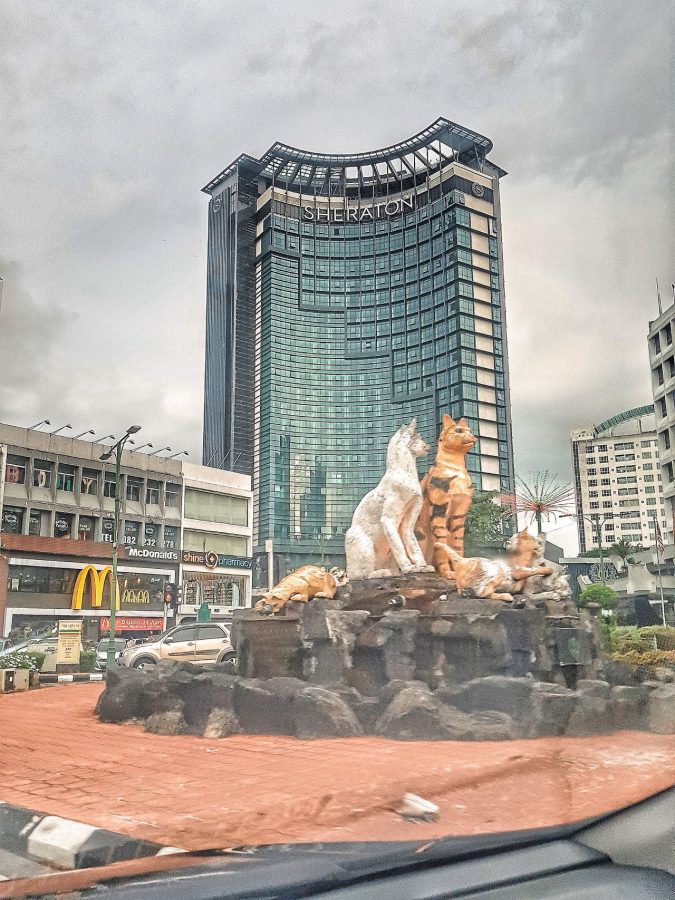
The bustling heart of Kuching, Chinatown is a hotchpotch of vintage shophouses, street art, and the most wonderful food offerings. While in town, Sarawak’s famed kolo mee is a must-try at the family-owned Kim Joo, a tiny shop on Carpenter Street that serves fat, lardy noodles with a vinegary tang and a generous dollop of minced meat. Go for the ‘spare parts’ version if you’re feeling adventurous, a bowl that sports the same noodle with pork innards. A little further up the street, Lao Ya Keng, also known as the Teochew Association, is a diversion from the ordinary with its food court within a Chinese temple setting. Ordering everything the locals rave about, we particularly liked the assam laksa and silky kueh chap flat noodles with chunks of meaty gravy. The heavily tattooed vendor chopping away at a massive loin flashes a smile as I raise my camera, his tribal tattoos the perfect example of how rainforest traditions have blended with that of contemporary Sarawakians. In response to our compliments, he points out a local tattoo parlour across the road where artists still use the traditional hand-tapping method to apply tattoo ink in the tribal bunga terung design, and now, more modern options.
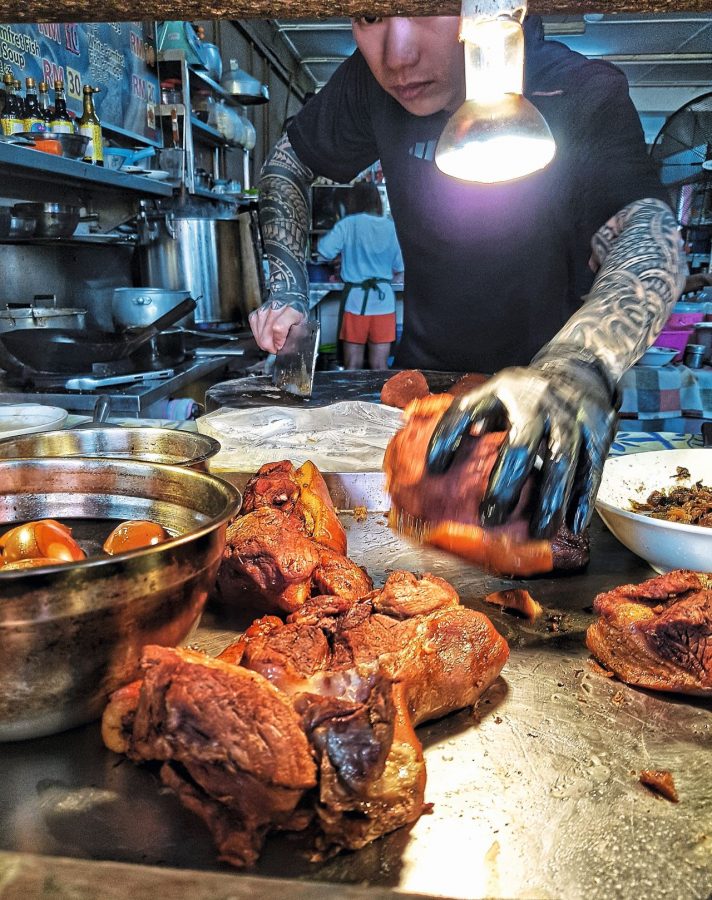
WATERFRONT WANDERING
Kuching’s crowds are focused on the south bank of the Sarawak River, which is also where the overseas Chinese live, with its key structures all painted in blue. Featuring green architecture, the less busy north bank is home to mainly Malaysians and the Bumi tribe people. A charming way to get a panoramic view of the city would be to hop on a sampan,or river taxi. Alternatively, go for the luxury option – the Sarawak River cruise that departs each evening, complete with refreshments and a cultural performance. Amidst the iconic buildings along the riverbank, including the familiar umbrella-roofed Sarawak Legislative Assembly and historical Fort Margherita, a highlight to look out for would be the 330m-long Golden Anniversary Bridge. Officially opened in late 2017, the bridge has become the city’s new signature, with its unique curve spanning the river. Bright and bustling at night, especially on weekends, the Kuching Waterfront is a crowd-puller where you’ll also be able to access the bridge on foot. While you’re there, pick up some quintessential Sarawakian takeaways from the kuih lapis or layer cake shops on the street – each packed with delicious, colourful offerings. A kaftan or sundress in a selected tribal print for your girlfriend back home? You’ll be spoilt for choice by the creative ways locals have woven their traditional culture into these little pieces of delight for you to take with you. And not to be forgotten, of course, a pack of famed Sarawak pepper to go.
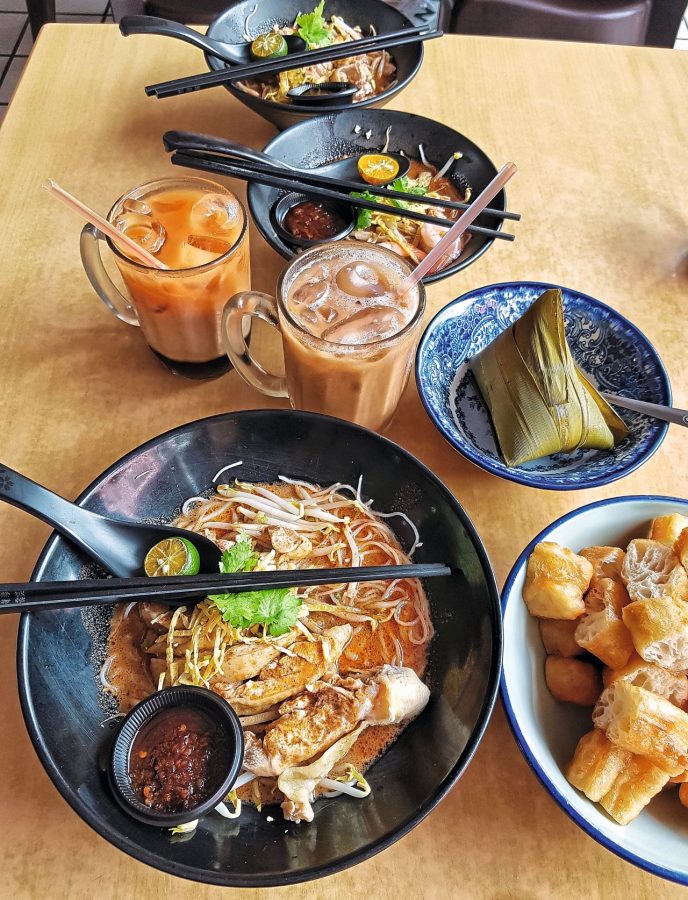
Shopping expedition complete, reward yourself with a dirty chai latte at Commons, housed in the old courthouse that dates back to 1883, then continue your historical jaunt with a visit to Fort Margherita across the road, where you can acquaint yourself with the fascinating legacy of the White Rajahs. A dynastic monarchy of England’s Brooke family, they founded and ruled the Raj of Sarawak on the northwest coast of Borneo from 1841 – 1946. The fort was built in 1879, during the reign of Charles, nephew to the first Rajah, James Brooke. A little further down the waterfront, the pastel pink Chinese History Museum offers a glimpse of long-forgotten migrant journeys to these strange foreign shores. And on raised ground across the street near the Harbour View hotel, their place of worship, the beautiful little Tua Pek Kong temple still stands after nearly two centuries. The temple is particularly lovely on moonlit nights, when perfumed smoke emanates from giant joss sticks and its many red lanterns glow.
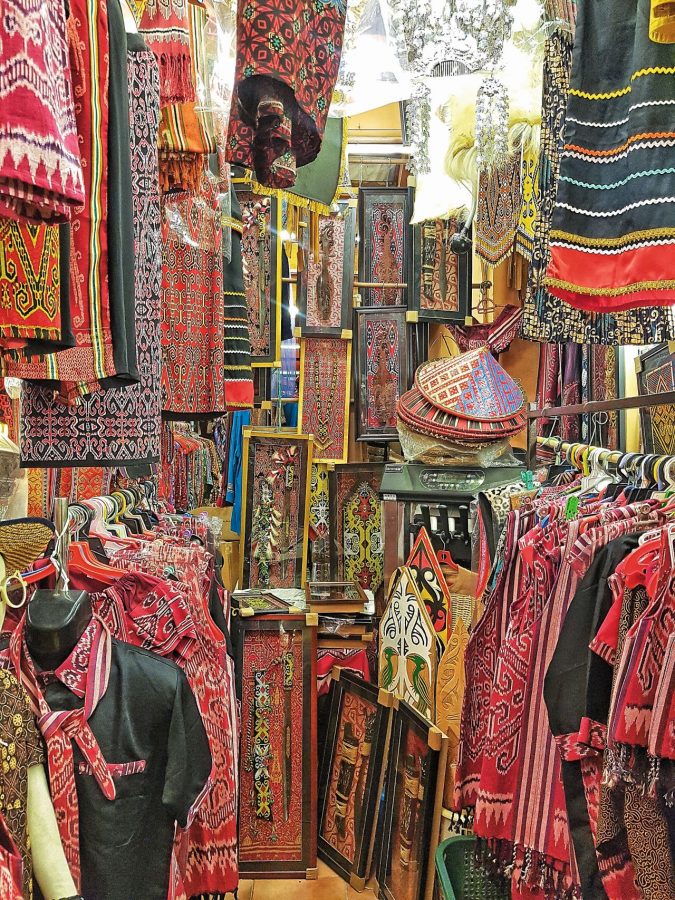
AN EXPLORATION OF HERITAGE
For history and culture buffs, Kuching is quite the treasure trove. Begin your trail at the impressive new Borneo Cultures Museum, or retrace the passage of time at the original Sarawak Museum, a colonial vision in black and white. Among the artifacts at the latter are a selection of intriguing earthenware. Ranging from tiny, elegantly detailed bowls to much larger vessels, over a metre in height, the jars were used for storage, brewing rice wine and making payments – dowries and fines for adultery and divorce settlements.
Once, the most valuable jars were only used for ceremonies like Gawai Kenyalang, a coming-of-age ceremony, or for funerals. When a member of the Kelabit tribe died, the corpse was packed into a jar in a foetal position to await rebirth from the jar – its ‘womb.’ The Berawan tribe did the same, and as decomposition took place, the liquid from the body was drained through a bamboo pipe, leaving the individual’s bones to be placed in a receptacle and hoisted onto a crypt above the riverbank. The belief was that the jars could foretell the future and summon spirits through the sounds they emitted when struck. In the same vicinity on the Padang Merdeka field, a monumental ancient cotton tree that must surely have borne witness to historical events of other kinds reaches its boughs to the sky. A giant covered with white blossoms that shed a white cotton carpet on the grass and into the air, it only flowers once every two to three years and we were fortunate to have caught such something so rare and precious. Definitely worth a quiet thanksgiving at the serene St Thomas cathedral, a relic of the 1950s which faces the field.
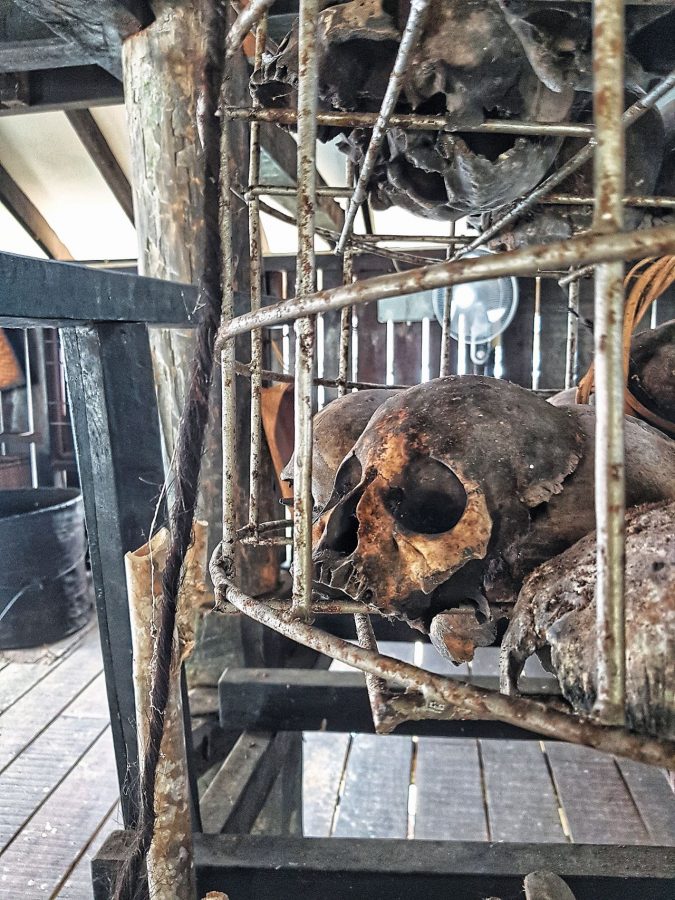
With its multi-cultural offerings, rich history, and edgy architectural additions, Kuching is the crown of Sarawak, Malaysia’s largest state by far. Yet, the land also packs in a host of national parks, an immense showcase of coastal swamp forests to vast cave systems and other natural wonders, preserving some of the world’s richest and most diverse ecosystems. Opportunities abound for a short or extended trek both inside and outside these protected areas, and it is also possible to visit remote longhouse communities, some of which can only be reached by venturing far upriver. Santubong, Kuching’s famed mythical mountain, presides over the city, but is within an hour’s drive away and makes an enjoyable hike for adventure seekers. Deep in the Sarawakian rainforests, eight of the world’s 54 species of hornbills soar free. A protected species in the state, the hornbill is featured on Sarawak’s state crest, considered by the Dayak Sarawakian tribe to represent the spirit of God.
As our trip was rather short, we opted instead to visit the wild man of the forest – the orangutan at Semenggoh Wildlife Centre, one of three orangutan rehabilitation centres in Malaysia where semi-wild orangutans can still be observed in their natural jungle surroundings. On arrival at the viewing deck some distance into the jungle, we were told that the primates might not come as it was fruit season and they had a jungle bounty to sustain them. To our delight, however, our wait wasn’t for nothing when a huge male came swinging in for a leisurely bite of the tropical fruit buffet laid out in invitation.
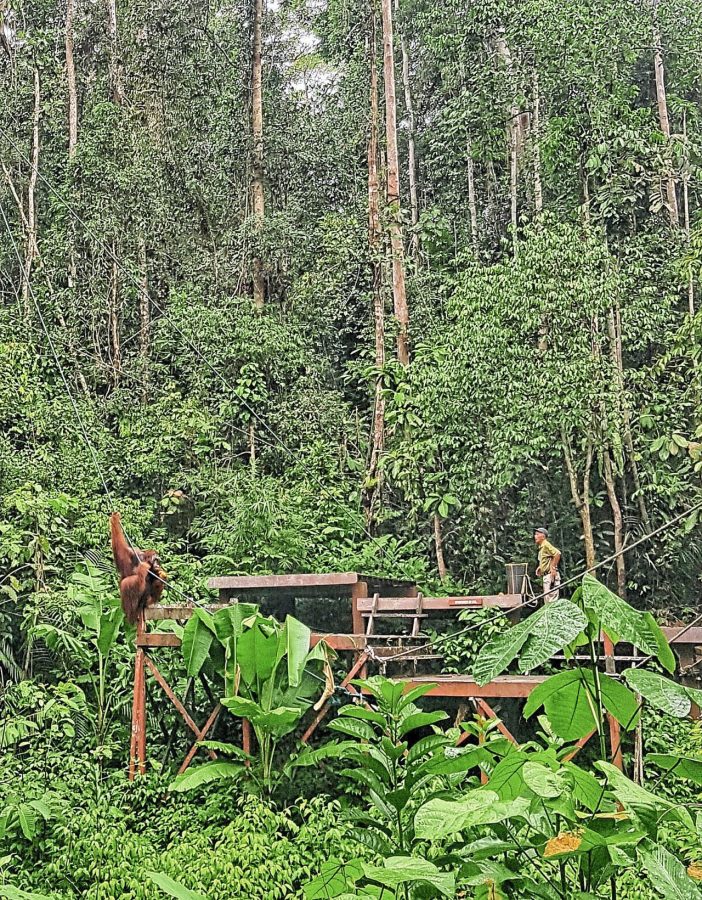
Kuching has an urban façade, but deep within its wild jungle lands, a tribal heart still beats with myths and legends, told and retold by those who remember. It held me completely in its thrall, and I will remember every fascinating moment – until I return once again.
"ExpatGo welcomes and encourages comments, input, and divergent opinions. However, we kindly request that you use suitable language in your comments, and refrain from any sort of personal attack, hate speech, or disparaging rhetoric. Comments not in line with this are subject to removal from the site. "


